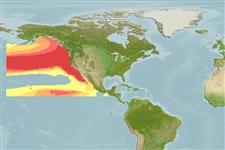>
Carangiformes (Jacks) >
Carangidae (Jacks and pompanos) > Caranginae
Etymology: Trachurus: Greek, trachys, -eia, -ys = rough + Greek, oura = tail (Ref. 45335); symmetricus: From symmetricus which means regularly formed - referring to the rough tail (Ref. 6885).
More on author: Ayres.
Environment: milieu / climate zone / depth range / distribution range
Ökologie
seewasser; ozeanodrom (Ref. 51243); tiefenbereich 0 - 400 m. Subtropical; 65°N - 13°N
Eastern Pacific: southeastern Alaska to southern Baja California, Mexico and the Gulf of California; reported from Acapulco in Mexico and the Galapagos Islands.
Size / Gewicht / Alter
Maturity: Lm ? range ? - 31 cm
Max length : 81.0 cm TL Männchen/unbestimmt; (Ref. 2850); common length : 55.0 cm TL Männchen/unbestimmt; (Ref. 9283); max. veröff. Alter: 30 Jahre (Ref. 766)
Rückenflossenstacheln (insgesamt): 8 - 9; Rückenflossenweichstrahlen (insgesamt): 28-38; Afterflossenstacheln 1-2; Afterflossenweichstrahlen: 22 - 33; Wirbelzahl: 23 - 25. Small specimens may have an additional forward-directed spine at first dorsal origin (embedded in larger specimens).
Adults are often found offshore, up to 500 miles from the coast (Ref. 9283). They form large schools (Ref. 2850). Young frequently occur in school near kelp and under piers (Ref. 2850). They feed mainly on small crustaceans and fish larvae (Ref. 9283). Large individuals often move inshore and north in the summer (Ref. 2850). Marketed fresh, smoked, canned and frozen; eaten fried, broiled and baked (Ref. 9988).
Eschmeyer, W.N., E.S. Herald and H. Hammann, 1983. A field guide to Pacific coast fishes of North America. Boston (MA, USA): Houghton Mifflin Company. xii+336 p. (Ref. 2850)
IUCN Rote Liste Status (Ref. 130435)
Bedrohung für Menschen
Harmless
Nutzung durch Menschen
Fischereien: kommerziell; Sportfisch: ja
Mehr Information
ReferenzenAquakulturAquakultur ProfilZuchtlinienGenetikElectrophoresesVererbbarkeitKrankheitenVerarbeitungNutrientsMass conversion
Tools
Zusatzinformationen
Download XML
Internet Quellen
Estimates based on models
Preferred temperature (Ref.
123201): 7 - 16.2, mean 9.2 °C (based on 50 cells).
Phylogenetic diversity index (Ref.
82804): PD
50 = 0.5001 [Uniqueness, from 0.5 = low to 2.0 = high].
Bayesian length-weight: a=0.00977 (0.00587 - 0.01627), b=2.96 (2.82 - 3.10), in cm total length, based on LWR estimates for this species & Genus-body shape (Ref.
93245).
Trophic level (Ref.
69278): 3.6 ±0.2 se; based on diet studies.
Widerstandsfähigkeit (Ref.
120179): niedrig, Verdopplung der Population dauert 4,5 - 14 Jahre. (K=0.09-0.21;tm=2-3; tmax=30; Fec<50,000).
Fishing Vulnerability (Ref.
59153): High to very high vulnerability (66 of 100).
Climate Vulnerability (Ref.
125649): Moderate vulnerability (38 of 100).
Nutrients (Ref.
124155): Calcium = 256 [162, 427] mg/100g; Iron = 4.83 [2.91, 8.14] mg/100g; Protein = 19.8 [19.0, 20.6] %; Omega3 = 0.337 [0.227, 0.527] g/100g; Selenium = 34.8 [19.9, 61.1] μg/100g; VitaminA = 6.65 [1.75, 28.82] μg/100g; Zinc = 1.51 [1.11, 2.16] mg/100g (wet weight);
